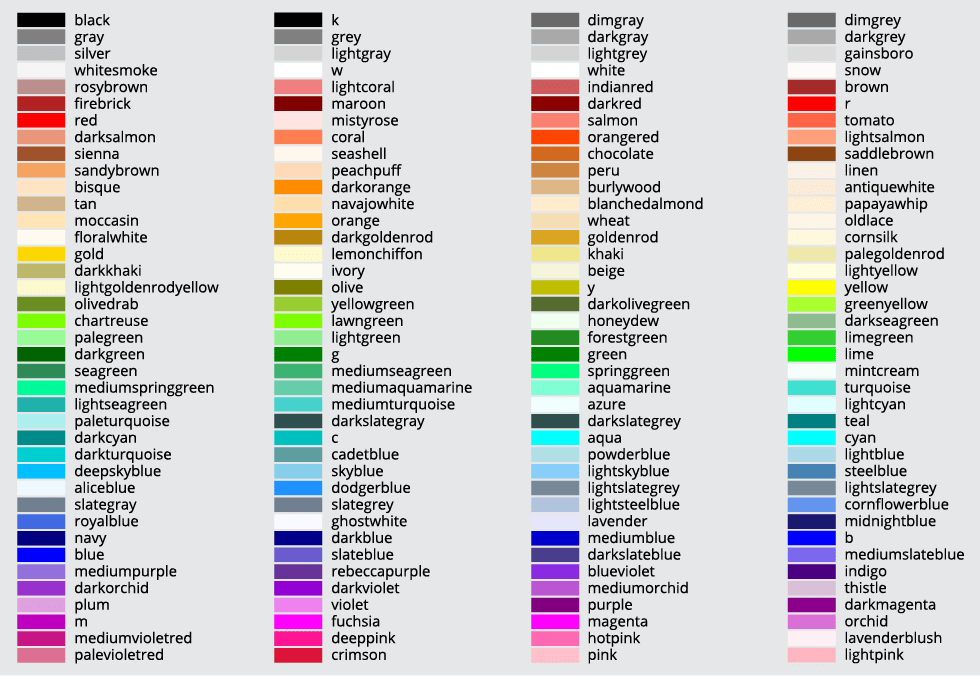

#Python colors code
This is more similar to specifying and RGB tuple rather than a named color (apart from the fact that the hex code is passed as a string), and I will not include an image of the 16 million colors you can choose from.įor more details, please refer to the matplotlib colors documentation and the source file specifying the available colors, _color_data.py. You can also plot colors by their HTML hex code: plt.plot(, lw=4, c='#8f9805') The default Tableau colors are available in matplotlib via the 'tab:' prefix: plt.plot(, lw=4, c='tab:green') Now you have access to a plethora of named colors! If you would like to use additional named colors when plotting with matplotlib, you can use the xkcd crowdsourced color names, via the 'xkcd:' prefix: plt.plot(, lw=4, c='xkcd:baby poop green') I merged my previous updates into this section.

X, Y = fig.get_dpi() * fig.get_size_inches()Īx.text(xi_text, y, name, fontsize=(h * 0.8), # Sort colors by hue, saturation, value and name.īy_hsv = sorted((tuple(mcolors.rgb_to_hsv(mcolors.to_rgba(color))), name) Ball Python Morphs are Ball Python snakes that have been selectively bred for a specific color or pattern appearance. changing The Whole Terminal color, using commands.
#Python colors install
Every color has some thought behind it, selecting the right color for an application is an art & it takes time to master it. Python-Colors-Windows Installation pip install python-colors-windows Note Since Windows Doesn't support Displaying string directly with color I have came with a simple solution.
#Python colors professional
It adds a professional touch to the application and helps in engaging the user for a longer time. import matplotlib.pyplot as pltĬolors = dict(mcolors.BASE_COLORS, **mcolors.CSS4_COLORS) Python Tkinter Colors Colors play an important role in the UI/UX of the application.

If colors are not supported than the color codes turn into empty strings. The module tries to check automatically if colors are supported. So it is an abstraction above the whole '\033 xx' thing. I really didn't change much from the matplotlib example, but here is the code for completeness. This is a module that assigns terminal ansi formatting codes to variables. Provides attributes that allow you to strip, convert and wrap ANSI codes. Only provides color formatting for console display. Cross-platform printing of colored text can be done using’s constant shorthand for ANSI escape sequences. I updated the image and code to reflect that 'rebeccapurple' has been added and the three sage colors have been moved under the 'xkcd:' prefix since I posted this answer originally. termcolor is a python module for ANSII Color formatting for output in the terminal. The order is not identical to how I would sort by eye, but I think it gives a good overview. Contains constants for 551 named colors (e. I couldn’t find anything like this, so I created a colorconstants module that. For Pygame and other graphics work, it’s helpful to have color constants that hold the color RGB values. I prefer the colors to be grouped with similar colors, so I slightly tweaked the matplotlib answer that was mentioned in a comment above to get a color list sorted in columns. Python Color Constants Module See Python: Tips and Tricks for similar articles. You have to to provide an amount of red, green, blue.

Of course this would probably require a compatible terminal (most modern terminals are) but I could fallback to the original logging output if color isn't supported. Colors may be specified as an RGB triplet or in hexadecimal format (a hex triplet) or according to their common English names in some cases. The previous answers are great, but I find it a bit difficult to get an overview of the available colors from the posted image. You can change the color of bars in a barplot using color argument. Is there any way to make the Python logging module output in color What I want (for instance) errors in red, debug messages in blue or yellow, and so on. import matplotlib.pyplot as plt import matplotlib.patches as patches import lors as colors import math fig plt.figure() ax fig.addsubplot(111) ratio 1.0 / 3.0 count math.ceil(math.sqrt(len(colors.cnames))) xcount count ratio ycount count / ratio x 0 y 0 w 1 / xcount h 1 / ycount for cl in colors.cnames: pos (x / xcount, y / ycount) ax.addpatch(patches.Rectangle(pos, w, h, colorcl)) ax.annotate(cl, xypos) if y > ycount-1: x + 1 y 0 else: y. Opencv js convert to grayscale.I constantly forget the names of the colors I want to use and keep coming back to this question =) Write and run code in 50+ languages online with Replit, a powerful IDE, compiler.


 0 kommentar(er)
0 kommentar(er)
